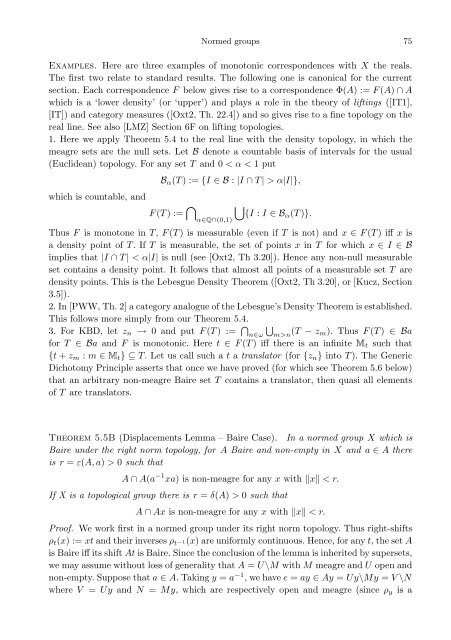Normed versus topological groups: Dichotomy and duality
Normed versus topological groups: Dichotomy and duality
Normed versus topological groups: Dichotomy and duality
Create successful ePaper yourself
Turn your PDF publications into a flip-book with our unique Google optimized e-Paper software.
<strong>Normed</strong> <strong>groups</strong> 75Examples. Here are three examples of monotonic correspondences with X the reals.The first two relate to st<strong>and</strong>ard results. The following one is canonical for the currentsection. Each correspondence F below gives rise to a correspondence Φ(A) := F (A) ∩ Awhich is a ‘lower density’ (or ‘upper’) <strong>and</strong> plays a role in the theory of liftings ([IT1],[IT]) <strong>and</strong> category measures ([Oxt2, Th. 22.4]) <strong>and</strong> so gives rise to a fine topology on thereal line. See also [LMZ] Section 6F on lifting topologies.1. Here we apply Theorem 5.4 to the real line with the density topology, in which themeagre sets are the null sets. Let B denote a countable basis of intervals for the usual(Euclidean) topology. For any set T <strong>and</strong> 0 < α < 1 putwhich is countable, <strong>and</strong>B α (T ) := {I ∈ B : |I ∩ T | > α|I|},F (T ) := ⋂ α∈Q∩(0,1)⋃{I : I ∈ Bα (T )}.Thus F is monotone in T, F (T ) is measurable (even if T is not) <strong>and</strong> x ∈ F (T ) iff x isa density point of T. If T is measurable, the set of points x in T for which x ∈ I ∈ Bimplies that |I ∩ T | < α|I| is null (see [Oxt2, Th 3.20]). Hence any non-null measurableset contains a density point. It follows that almost all points of a measurable set T aredensity points. This is the Lebesgue Density Theorem ([Oxt2, Th 3.20], or [Kucz, Section3.5]).2. In [PWW, Th. 2] a category analogue of the Lebesgue’s Density Theorem is established.This follows more simply from our Theorem 5.4.⋃m>n (T − z m). Thus F (T ) ∈ Ba3. For KBD, let z n → 0 <strong>and</strong> put F (T ) := ⋂ n∈ωfor T ∈ Ba <strong>and</strong> F is monotonic. Here t ∈ F (T ) iff there is an infinite M t such that{t + z m : m ∈ M t } ⊆ T. Let us call such a t a translator (for {z n } into T ). The Generic<strong>Dichotomy</strong> Principle asserts that once we have proved (for which see Theorem 5.6 below)that an arbitrary non-meagre Baire set T contains a translator, then quasi all elementsof T are translators.Theorem 5.5B (Displacements Lemma – Baire Case). In a normed group X which isBaire under the right norm topology, for A Baire <strong>and</strong> non-empty in X <strong>and</strong> a ∈ A thereis r = ε(A, a) > 0 such thatA ∩ A(a −1 xa) is non-meagre for any x with ‖x‖ < r.If X is a <strong>topological</strong> group there is r = δ(A) > 0 such thatA ∩ Ax is non-meagre for any x with ‖x‖ < r.Proof. We work first in a normed group under its right norm topology. Thus right-shiftsρ t (x) := xt <strong>and</strong> their inverses ρ t −1(x) are uniformly continuous. Hence, for any t, the set Ais Baire iff its shift At is Baire. Since the conclusion of the lemma is inherited by supersets,we may assume without loss of generality that A = U\M with M meagre <strong>and</strong> U open <strong>and</strong>non-empty. Suppose that a ∈ A. Taking y = a −1 , we have e = ay ∈ Ay = Uy\My = V \Nwhere V = Uy <strong>and</strong> N = My, which are respectively open <strong>and</strong> meagre (since ρ y is a
















